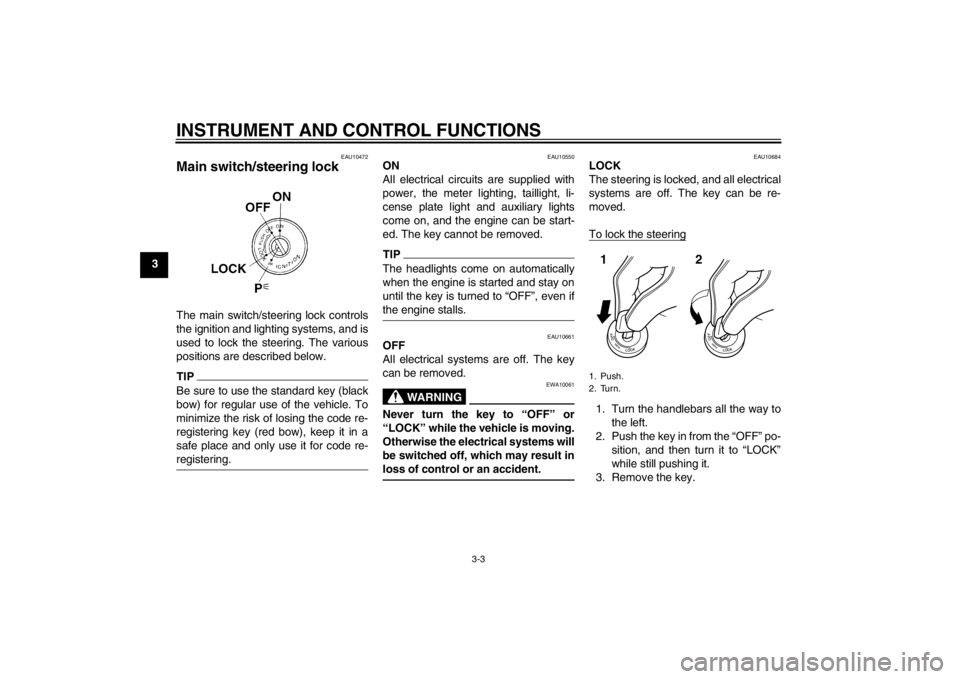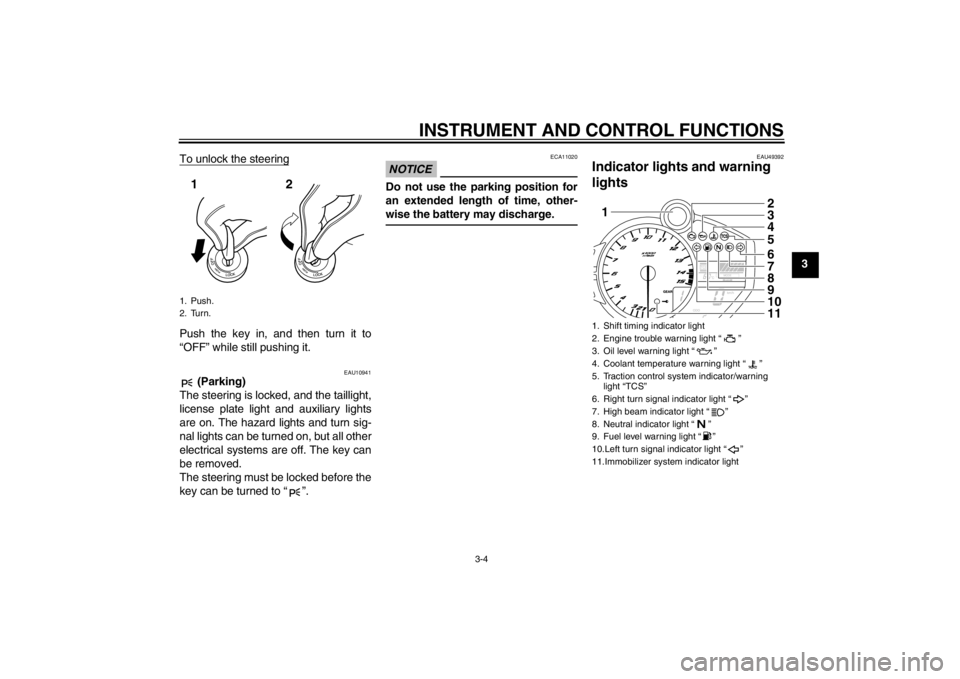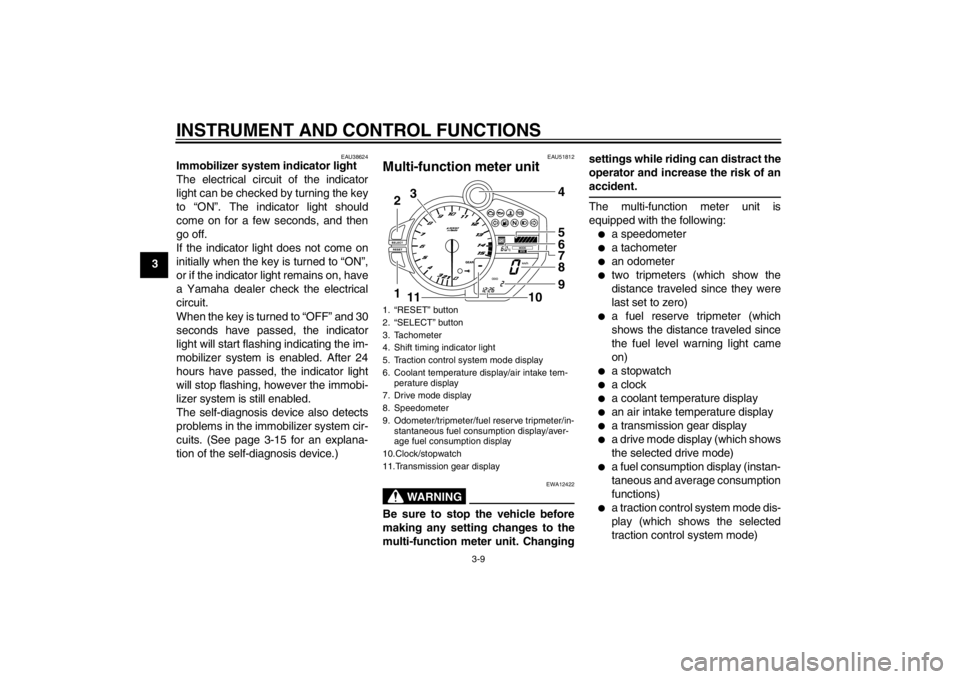warning light YAMAHA YZF-R1 2013 Owners Manual
[x] Cancel search | Manufacturer: YAMAHA, Model Year: 2013, Model line: YZF-R1, Model: YAMAHA YZF-R1 2013Pages: 112, PDF Size: 2.79 MB
Page 6 of 112

TABLE OF CONTENTSSAFETY INFORMATION ..................1-1
DESCRIPTION ..................................2-1
Left view ..........................................2-1
Right view ........................................2-2
Controls and instruments.................2-3
INSTRUMENT AND CONTROL
FUNCTIONS .......................................3-1
D-mode (drive mode) ......................3-1
Immobilizer system .........................3-1
Main switch/steering lock ................3-3
Indicator lights and warning lights ..............................3-4
Multi-function meter unit .................3-9
Handlebar switches ......................3-18
Clutch lever ...................................3-20
Shift pedal .....................................3-20
Brake lever ...................................3-20
Brake pedal ..................................3-21
Traction control system ................3-21
Fuel tank cap ................................3-24
Fuel ...............................................3-24
Fuel tank breather hose and overflow hose ............................3-26
Catalytic converter ........................3-26
Seats ............................................3-27
Helmet holder ...............................3-28
Storage compartment ...................3-29
Rider footrest position ...................3-29
Rear view mirrors .........................3-30 Adjusting the front fork ................. 3-30
Adjusting the shock absorber
assembly ................................... 3-32
Luggage strap holders ................. 3-34
Sidestand ..................................... 3-35
Ignition circuit cut-off system ........ 3-35
FOR YOUR SAFETY –
PRE-OPERATION CHECKS ............. 4-1
OPERATION AND IMPORTANT
RIDING POINTS ................................. 5-1
Starting the engine ......................... 5-1
Shifting ........................................... 5-2
Tips for reducing fuel consumption ............................... 5-3
Engine break-in .............................. 5-3
Parking ........................................... 5-4
PERIODIC MAINTENANCE AND
ADJUSTMENT ................................... 6-1
Owner’s tool kit ............................... 6-2
Periodic maintenance chart for the emission control system ............. 6-3
General maintenance and lubrication chart .......................... 6-4
Removing and installing cowlings ...................................... 6-8
Checking the spark plugs ............. 6-10
Engine oil and oil filter cartridge ... 6-11
Coolant ......................................... 6-14 Air filter element ........................... 6-17
Checking the engine idling
speed ........................................ 6-17
Checking the throttle grip free play ........................................... 6-18
Valve clearance ........................... 6-18
Tires ............................................. 6-18
Cast wheels ................................. 6-21
Adjusting the clutch lever free play ........................................... 6-21
Checking the brake lever free
play ........................................... 6-22
Brake light switches ..................... 6-23
Checking the front and rear brake pads ........................ 6-23
Checking the brake fluid level ...... 6-24
Changing the brake fluid .............. 6-25
Drive chain slack .......................... 6-25
Cleaning and lubricating the drive chain .......................... 6-27
Checking and lubricating the cables ................................. 6-27
Checking and lubricating
the throttle grip and cable ......... 6-28
Checking and lubricating the brake and shift pedals ........ 6-28
Checking and lubricating the brake and clutch levers ...... 6-29
Checking and lubricating
the sidestand ............................ 6-29U1KBE1E0.book Page 1 Monday, July 9, 2012 1:05 PM
Page 18 of 112

INSTRUMENT AND CONTROL FUNCTIONS
3-3
3
EAU10472
Main switch/steering lock The main switch/steering lock controls
the ignition and lighting systems, and is
used to lock the steering. The various
positions are described below.TIPBe sure to use the standard key (black
bow) for regular use of the vehicle. To
minimize the risk of losing the code re-
registering key (red bow), keep it in a
safe place and only use it for code re-
registering.
EAU10550
ON
All electrical circuits are supplied with
power, the meter lighting, taillight, li-
cense plate light and auxiliary lights
come on, and the engine can be start-
ed. The key cannot be removed.TIPThe headlights come on automatically
when the engine is started and stay on
until the key is turned to “OFF”, even if
the engine stalls.
EAU10661
OFF
All electrical systems are off. The key
can be removed.
WARNING
EWA10061
Never turn the key to “OFF” or
“LOCK” while the vehicle is moving.
Otherwise the electrical systems will
be switched off, which may result in
loss of control or an accident.
EAU10684
LOCK
The steering is locked, and all electrical
systems are off. The key can be re-
moved.
To lock the steering1. Turn the handlebars all the way tothe left.
2. Push the key in from the “OFF” po- sition, and then turn it to “LOCK”
while still pushing it.
3. Remove the key.1. Push.
2. Turn.12
U1KBE1E0.book Page 3 Monday, July 9, 2012 1:05 PM
Page 19 of 112

INSTRUMENT AND CONTROL FUNCTIONS
3-4
3
To unlock the steering
Push the key in, and then turn it to
“OFF” while still pushing it.
EAU10941
(Parking)
The steering is locked, and the taillight,
license plate light and auxiliary lights
are on. The hazard lights and turn sig-
nal lights can be turned on, but all other
electrical systems are off. The key can
be removed.
The steering must be locked before the
key can be turned to “ ”.
NOTICE
ECA11020
Do not use the parking position for
an extended length of time, other-
wise the battery may discharge.
EAU49392
Indicator lights and warning
lights
1. Push.
2. Turn.12
1. Shift timing indicator light
2. Engine trouble warning light “ ”
3. Oil level warning light “ ”
4. Coolant temperature warning light “ ”
5. Traction control system indicator/warning light “TCS”
6. Right turn signal indicator light “ ”
7. High beam indicator light “ ”
8. Neutral indicator light “ ”
9. Fuel level warning light “ ”
10.Left turn signal indicator light “ ”
11.Immobilizer system indicator light1 2
34561178910
U1KBE1E0.book Page 4 Monday, July 9, 2012 1:05 PM
Page 20 of 112

INSTRUMENT AND CONTROL FUNCTIONS
3-5
3
EAU11030
Turn signal indicator lights “ ”
and “ ”
The corresponding indicator light flash-
es when the turn signal switch is
pushed to the left or right.
EAU11060
Neutral indicator light “ ”
This indicator light comes on when the
transmission is in the neutral position.
EAU11080
High beam indicator light “ ”
This indicator light comes on when the
high beam of the headlight is switched
on.
EAU11254
Oil level warning light “ ”
This warning light comes on if the en-
gine oil level is low.
The electrical circuit of the warning light
can be checked by turning the key to
“ON”. The warning light should come
on for a few seconds, and then go off.
If the warning light does not come on
initially when the key is turned to “ON”,
or if the warning light remains on, have
a Yamaha dealer check the electrical
circuit.
TIP●
Even if the oil level is sufficient, the
warning light may flicker when
riding on a slope or during sudden
acceleration or deceleration, but
this is not a malfunction.
●
This model is also equipped with a
self-diagnosis device for the oil
level detection circuit. If a problem
is detected in the oil level detection
circuit, the following cycle will be
repeated until the malfunction is
corrected: The oil level warning
light will flash ten times, then go off
for 2.5 seconds. If this occurs,
have a Yamaha dealer check the
vehicle.
EAU11366
Fuel level warning light “ ”
This warning light comes on when the
fuel level drops below approximately
3.1 L (0.82 US gal, 0.68 Imp.gal). When
this occurs, refuel as soon as possible.
The electrical circuit of the warning light
can be checked by turning the key to
“ON”. The warning light should come
on for a few seconds, and then go off.If the warning light does not come on
initially when the key is turned to “ON”,
or if the warning light remains on, have
a Yamaha dealer check the electrical
circuit.
TIPThis model is also equipped with a self-
diagnosis device for the fuel level de-
tection circuit. If a problem is detected
in the fuel level detection circuit, the fol-
lowing cycle will be repeated until the
malfunction is corrected: The fuel level
warning light will flash eight times, and
then go off for 3.0 seconds. If this oc-
curs, have a Yamaha dealer check the
vehicle.
EAU47752
Coolant temperature warning
light “ ”
This warning light comes on if the en-
gine overheats. If this occurs, stop the
engine immediately and allow the en-
gine to cool.
The electrical circuit of the warning light
can be checked by turning the key to
“ON”. The warning light should come
on for a few seconds, and then go off.
U1KBE1E0.book Page 5 Monday, July 9, 2012 1:05 PM
Page 21 of 112

INSTRUMENT AND CONTROL FUNCTIONS
3-6
3
If the warning light does not come on
initially when the key is turned to “ON”,
or if the warning light remains on, have
a Yamaha dealer check the electrical
circuit.
NOTICE
ECA10021
Do not continue to operate the en-
gine if it is overheating.TIP●
For radiator-fan-equipped vehi-
cles, the radiator fan(s) automati-
cally switch on or off according to
the coolant temperature in the ra-
diator.
●
If the engine overheats, see page
6-41 for further instructions.
U1KBE1E0.book Page 6 Monday, July 9, 2012 1:05 PM
Page 22 of 112

INSTRUMENT AND CONTROL FUNCTIONS
3-7
3
DisplayConditionsWhat to do
Under 39 °C
(Under 103 °F) Message “Lo” is displayed. OK. Go ahead with riding.
40–116 °C
(104–242 °F) Coolant temperature is dis-
played.
OK. Go ahead with riding.
Above 117 °C
(Above 243 °F) Coolant temperature flashes.
Warning light comes on.Stop the vehicle and allow it to idle until
the coolant temperature goes down.
If the temperature does not go down,
stop the engine. (See page 6-41.)
U1KBE1E0.book Page 7 Monday, July 9, 2012 1:05 PM
Page 23 of 112

INSTRUMENT AND CONTROL FUNCTIONS
3-8
3
EAU11534
Engine trouble warning light “ ”
This warning light comes on or flashes
if a problem is detected in the electrical
circuit monitoring the engine. If this oc-
curs, have a Yamaha dealer check the
self-diagnosis system. (See page 3-15
for an explanation of the self-diagnosis
device.)
The electrical circuit of the warning light
can be checked by turning the key to
“ON”. The warning light should come
on for a few seconds, and then go off.
If the warning light does not come on
initially when the key is turned to “ON”,
or if the warning light remains on, have
a Yamaha dealer check the electrical
circuit.
EAU51850
Traction control system indica-
tor/warning light “TCS”
This indicator/warning light flashes
when the traction control system en-
gages.
The electrical circuit of the light can be
checked by turning the key to “ON”.
The light should come on for a few sec-
onds, and then go off.If the light does not come on initially
when the key is turned to “ON”, or if the
light remains on, have a Yamaha deal-
er check the electrical circuit.
When the traction control system is set
to a “TCS” mode other than “OFF”, and
the traction control system is operating,
the indicator light flashes.
If the traction control system disables
while riding, “TCS OFF” is displayed,
and the indicator/warning light and en-
gine trouble warning light come on.
(See page 3-21 for an explanation of
the traction control system.)
Try to reset the traction control system
and the lights by following the proce-
dures under “Resetting” on page 3-23.
EAU11574
Shift timing indicator light
This indicator light can be set to come
on and go off at the desired engine
speeds and is used to inform the rider
when it is time to shift to the next higher
gear.
The electrical circuit of the indicator
light can be checked by turning the key
to “ON”. The indicator light should
come on for a few seconds, and then
go off.
If the indicator light does not come on
initially when the key is turned to “ON”,
or if the indicator light remains on, have
a Yamaha dealer check the electrical
circuit. (See page 3-16 for a detailed
explanation of the function of this indi-
cator light and on how to set it.)
1. Engine trouble warning light “ ”
2. Traction control system indicator/warning
light “TCS”
3. Traction control system mode display
123
U1KBE1E0.book Page 8 Monday, July 9, 2012 1:05 PM
Page 24 of 112

INSTRUMENT AND CONTROL FUNCTIONS
3-9
3
EAU38624
Immobilizer system indicator light
The electrical circuit of the indicator
light can be checked by turning the key
to “ON”. The indicator light should
come on for a few seconds, and then
go off.
If the indicator light does not come on
initially when the key is turned to “ON”,
or if the indicator light remains on, have
a Yamaha dealer check the electrical
circuit.
When the key is turned to “OFF” and 30
seconds have passed, the indicator
light will start flashing indicating the im-
mobilizer system is enabled. After 24
hours have passed, the indicator light
will stop flashing, however the immobi-
lizer system is still enabled.
The self-diagnosis device also detects
problems in the immobilizer system cir-
cuits. (See page 3-15 for an explana-
tion of the self-diagnosis device.)
EAU51812
Multi-function meter unit
WARNING
EWA12422
Be sure to stop the vehicle before
making any setting changes to the
multi-function meter unit. Changingsettings while riding can distract the
operator and increase the risk of an
accident.
The multi-function meter unit is
equipped with the following:●
a speedometer
●
a tachometer
●
an odometer
●
two tripmeters (which show the
distance traveled since they were
last set to zero)
●
a fuel reserve tripmeter (which
shows the distance traveled since
the fuel level warning light came
on)
●
a stopwatch
●
a clock
●
a coolant temperature display
●
an air intake temperature display
●
a transmission gear display
●
a drive mode display (which shows
the selected drive mode)
●
a fuel consumption display (instan-
taneous and average consumption
functions)
●
a traction control system mode dis-
play (which shows the selected
traction control system mode)
1. “RESET” button
2. “SELECT” button
3. Tachometer
4. Shift timing indicator light
5. Traction control system mode display
6. Coolant temperature display/air intake tem-
perature display
7. Drive mode display
8. Speedometer
9. Odometer/tripmeter/fuel reserve tripmeter/in- stantaneous fuel consumption display/aver-
age fuel consumption display
10.Clock/stopwatch
11.Transmission gear display2
1 3
4
5
6
7
8
9
10
11
U1KBE1E0.book Page 9 Monday, July 9, 2012 1:05 PM
Page 27 of 112

INSTRUMENT AND CONTROL FUNCTIONS
3-12
3
cancel the currently selected
mode, and then repeat step 1 to
select the desired mode.
●
To reset all the recorded times for
the selected split time history,
push the “RESET” button for at
least one second.
4. Push the “SELECT” button for at
least one second to cancel the split
time history and return to the time
measurement.
Odometer, tripmeter, instantaneous
fuel consumption and average fuel
consumption modes Push the “SELECT” button to switch
the display between the odometer
mode “ODO”, the tripmeter modes
“TRIP 1” and “TRIP 2”, the instanta-
neous fuel consumption mode “km/L”
or “L/100 km”, and the average fuel
consumption mode “AVE_ _._ km/L” or
“AVE_ _._ L/100 km” in the following or-
der:
ODO
→ TRIP 1 → TRIP 2 → km/L or
L/100 km → AVE_ _._ km/L or AVE_
_._ L/100 km → ODO
For the UK only:
Push the “SELECT” button to switch
the display between the odometer
mode “ODO”, the tripmeter modes
“TRIP 1” and “TRIP 2”, the instanta-
neous fuel consumption mode “km/L”,
“L/100 km” or “MPG”, and the average
fuel consumption mode “AVE_ _._
km/L”, “AVE_ _._ L/100 km” or “AVE_
_._ MPG” in the following order:
ODO → TRIP 1 → TRIP 2 → km/L,
L/100 km or MPG → AVE_ _._ km/L,
AVE_ _._ L/100 km or AVE_ _._ MPG
→ ODO If the fuel level warning light comes on
(see page 3-4), the display automatical-
ly changes to the fuel reserve tripmeter
mode “TRIP F” and starts counting the
distance traveled from that point. In that
case, push the “SELECT” button to
switch the display between the various
tripmeter, odometer, instantaneous fuel
consumption and average fuel con-
sumption modes in the following order:
TRIP F
→ km/L or L/100 km → AVE_
_._ km/L or AVE_ _._ L/100 km →
ODO → TRIP 1 → TRIP 2 → TRIP F
For the UK only:
TRIP F → km/L, L/100 km or MPG →
AVE_ _._ km/L, AVE_ _._ L/100 km or
AVE_ _._ MPG → ODO → TRIP 1 →
TRIP 2 → TRIP F
To reset a tripmeter, select it by push-
ing the “SELECT” button, and then
push the “RESET” button for at least
one second.1. Odometer/tripmeter/fuel reserve tripmeter/in- stantaneous fuel consumption display/aver-
age fuel consumption display
1
U1KBE1E0.book Page 12 Monday, July 9, 2012 1:05 PM
Page 30 of 112

INSTRUMENT AND CONTROL FUNCTIONS
3-15
3
TIP●
Even if the air intake temperature
is set to be displayed, the coolant
temperature warning light comes
on if the engine overheats.
●
When the key is turned to “ON”,
the coolant temperature is auto-
matically displayed, even if the air
intake temperature was displayed
prior to turning the key to “OFF”.
●
When the air intake temperature
display is selected, “A” is displayed
before the temperature.
Traction control system mode dis-
playThis display indicates which traction
control system mode has been select-
ed. For more details on the modes and
on how to select them, refer to page
3-21.
Self-diagnosis device
This model is equipped with a self-diag-
nosis device for various electrical cir-
cuits.
If a problem is detected in the immobi-
lizer system circuits, the immobilizer
system indicator light flashes and the
display indicates an error code.If a problem is detected in any other cir-
cuit, the engine trouble warning light
comes on and the display indicates an
error code.
If the display indicates any error codes,
note the code number, and then have a
Yamaha dealer check the vehicle.
TIPIf the display indicates immobilizer sys-
tem circuit error code 52, this could be
caused by transponder interference. If
this error code appears, try following
the procedure below.1. Use the code re-registering key to start the engine.TIPMake sure there are no other immobi-
lizer keys close to the main switch, and
do not keep more than one immobilizer
key on the same key ring! Immobilizer
system keys may cause signal interfer-
ence, which may prevent the engine
from starting.2. If the engine starts, turn it off andtry starting the engine with the
standard keys.
1. Traction control system mode display
1
1. Error code display
2. Immobilizer system indicator light
3. Engine trouble warning light “ ”
132
U1KBE1E0.book Page 15 Monday, July 9, 2012 1:05 PM